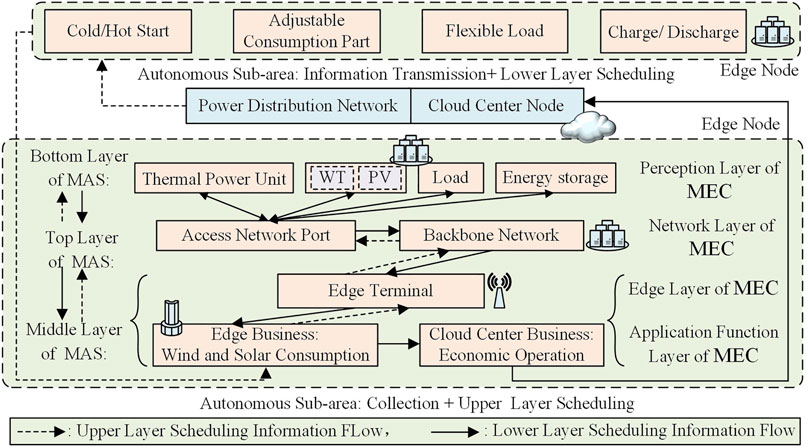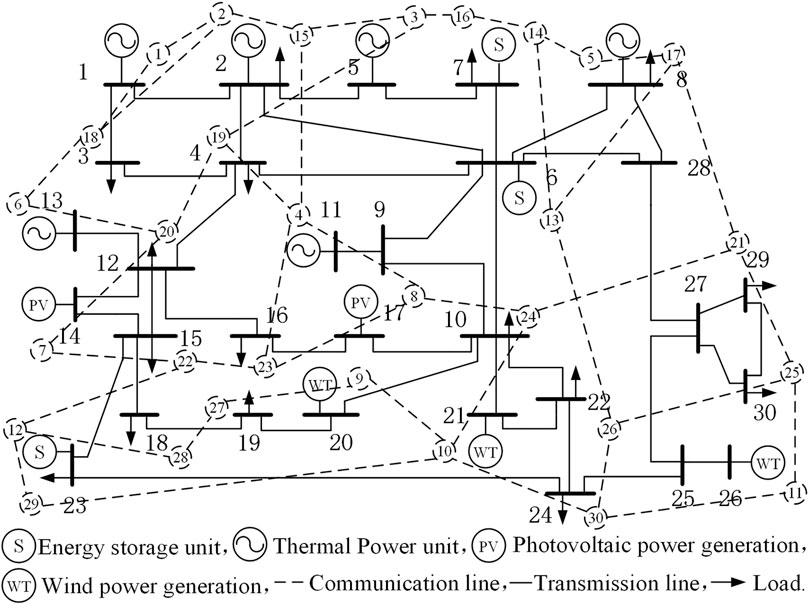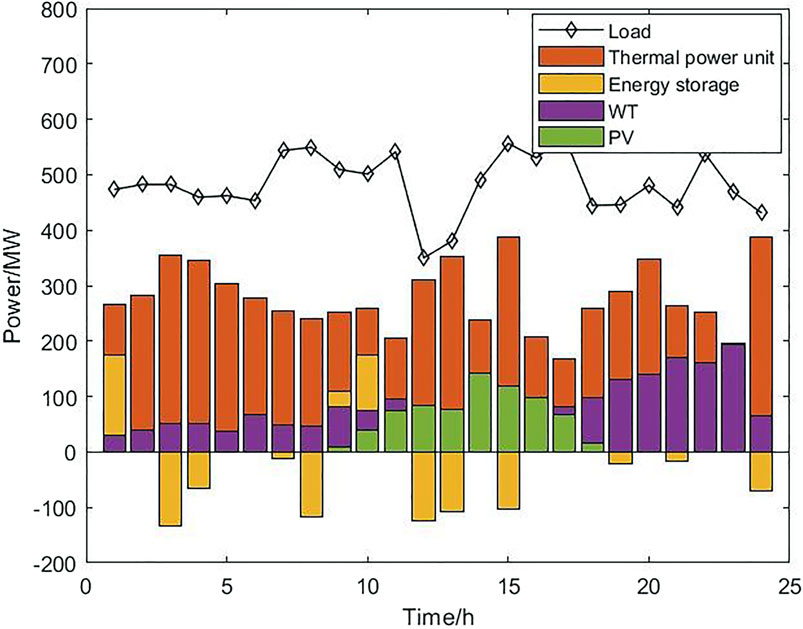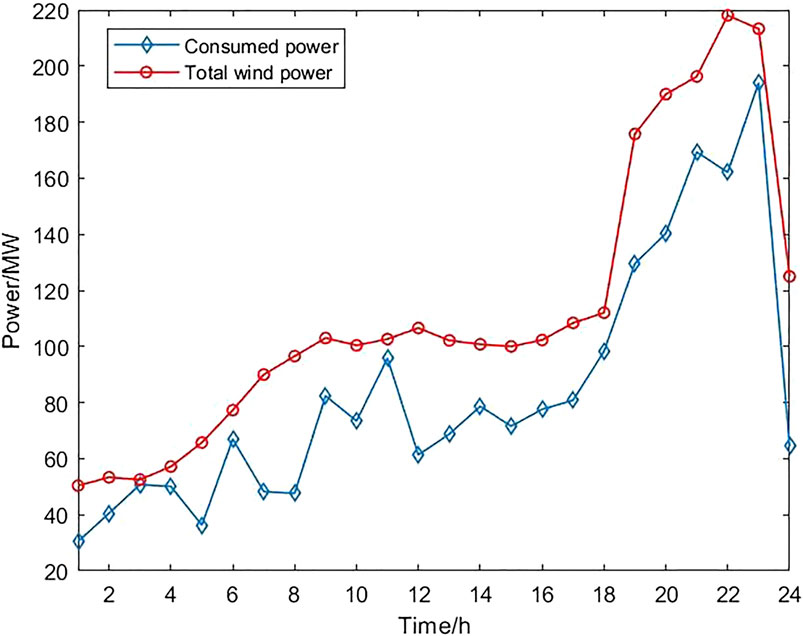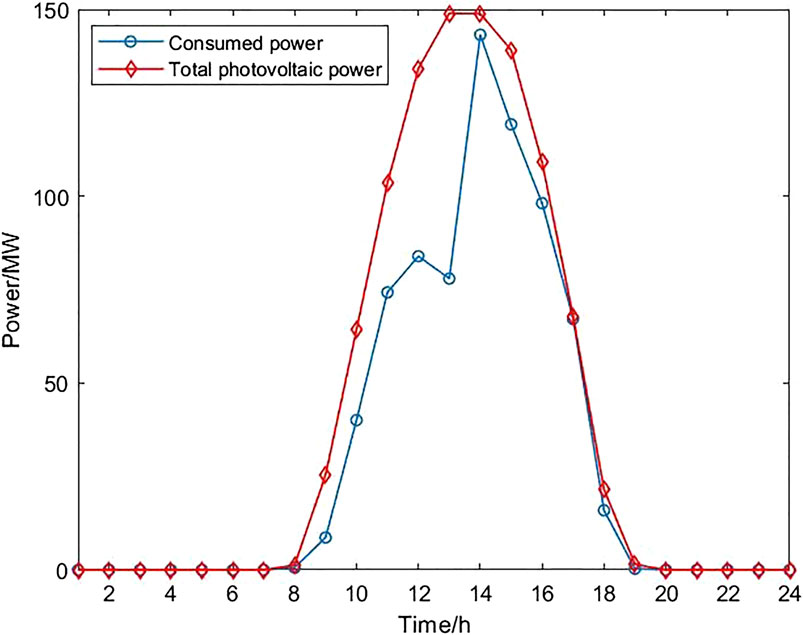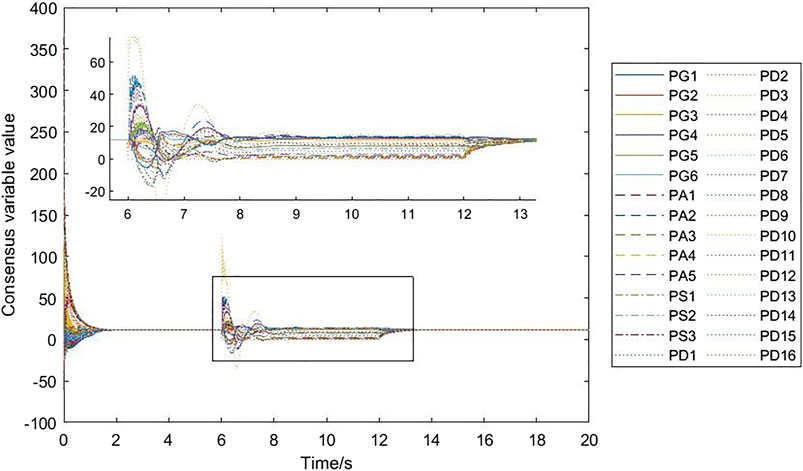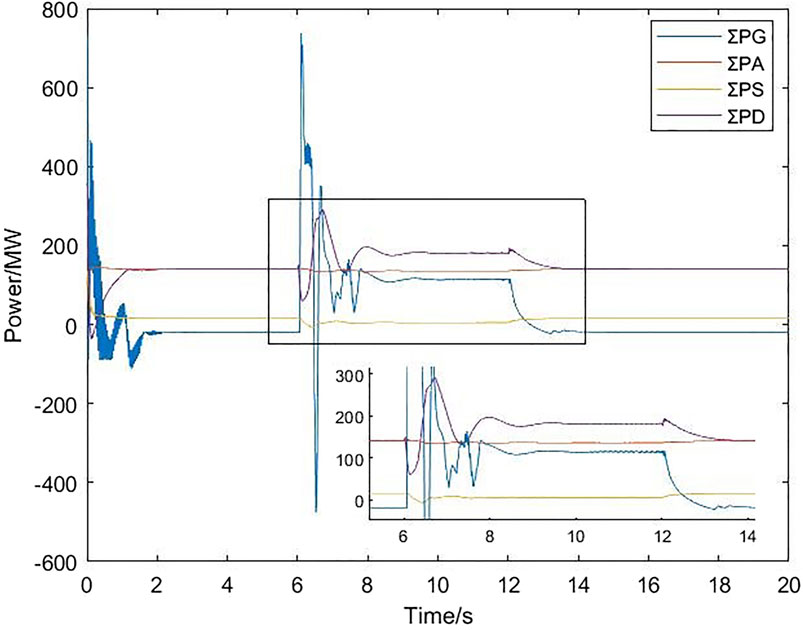- 1School of Electrical Engineering, Shenyang University of Technology, Shenyang, China
- 2College of Information, Shenyang Institute of Engineering, Shenyang, China
This paper presents a consensus dispatch model of the distributed power network based on multi-access edge computing (MEC) and multi-agent system (MAS).MEC decentralizes the processing and storage of data in the distributed power system to the edge node combined with MAS, which reduces the amount of calculation in the dispatch center. The model formulates different objective functions for the edge nodes and the cloud center nodes of the MEC to optimally allocate the output of each unit. Meanwhile, in order to meet the consensus dispatch of distributed units, the operational benefits of flexible load, the operating cost of thermal power units, the penalty cost of abandoning wind and solar power for new energy units, and the operation of energy storage devices are utilized as consensus variables. Based on these consensus variables, an optimal dispatch method of the distributed power network is established. Compared with the traditional dispatch model, this model integrates distributed units and autonomous sub-regions through MAS and MEC, which ensures the system performs consensus dispatch under the balance of supply and demand, and also improves the proportion of new energy consumption.
1 Introduction
With the penetration of renewable energy, the structure of the power system is facing many changes. Through the continuous upgrading of communication network technology, the power system develops rapidly towards scale and intelligence. The Ubiquitous Electric Internet of Things (UEIOT), which is built on a distributed power system, emerges at this moment (Li et al., 2017).The structure of distributed power systems is more complex than the traditional power transmission network. For example, the reduced-order aggregate model for large-scale converters with inhomogeneous initial conditions in DC microgrids, and reduced-order transfer function model of the droop-controlled inverter via Jordan continued-fraction expansion proposed in certain studies both involve large-scale power systems (Wang et al., 2020; Wang et al., 2021). With the development of large-scale power systems, the proportion of internal distributed power sources has gradually increased. The amount of data inside the UEIOT is also substantial based on distributed power systems, which brings tremendous pressure to the transmission and processing of power data.
In the context of continuous development of intelligent technology and large-scale growth of power data, many smart terminal devices have been deployed on the power distribution side. The basic configuration of UEIOT gradually takes shape, and the research on flexible dispatch of distributed power systems has attracted the attention of many scholars. In the existing research, edge computing (EC) technology is integrated into the power system. It calculates the data of power grid perception layer at the edge side, which saves time and cost of network transmission (Sun et al., 2019; Li et al., 2020). The role of EC is analyzed from the perspective of the practical application of the smart grid, which shows that the cloud-side collaboration mechanism of EC can better coordinate the information communication and flexible dispatch of distributed units (Li et al., 2018).Multi-access edge computing (MEC) derived from EC realizes high-speed access and read of terminal software using wireless network information. Multi-agent system (MAS) has good concentration and dispersion characteristics and is widely used in distributed power systems. For example, Kumar Nunna and Doolla (2013) utilizes a multi-agent system to control the power balance. MAS takes multiple microgrids as a whole to participate in the operation of the upper-layer network, which provides an idea for multi-unit control in distributed unit hierarchical dispatch.
The distributed control technology of MAS and the unique edge-side processing mechanism of EC can provide a novel operation framework for the multi-node and multi-stage optimization dispatch of the power system (He et al., 2019).However, due to the uncertain output of new energy sources, the high penetration of flexible loads, and the demand for “plug and play” of some power components, the topology of power network will change. Meanwhile, the centralized optimal dispatch for distributed units has higher requirements for the stability of the communication network between units, which may lead to unreasonable dispatch results (Gong et al., 2018).
Based on the technology of MEC-MAS, this paper establishes a hierarchical dispatch model with the maximum proportion of new energy consumption and the minimum cost of system operation. The model solves the optimal dispatch plan of distributed power systems by dividing consistent variables of each unit, and improves the proportion of new energy consumption and the system stability.
The main contributions of this paper are listed below:
1) The established power network communication model based on MEC-MAS can provide a stable operating framework for distributed systems;
2) The constructed hierarchical dispatching model composed of edge nodes and cloud centers is constructed. Compared with the traditional centralized processing mode, the edge processing of data can effectively improve the dispatching efficiency;
3) By dividing and solving the consensus variables through the objective function of the hierarchical dispatching model, the distributed units can optimize the unified objective under the constraints, and a better distributed power grid dispatching scheme can be obtained.
The remainder of this paper is organized as follows. Section 2 presents an EC model of the power system based on MAS. Section 3 establishes the distributed multi-agent consensus dispatch model. Section 4 shows the results of the case study. Section 5 illustrates the conclusion.
2 EC Model of the Power System Based on MAS
2.1 Integration of EC and Power System
With the large amount of new energy connected to the grid, the power supply mode is gradually transformed from the centralized to the distributed. Therefore, a distributed network topology is formulated among distributed power sources, energy storage systems and loads. For this topology, traditional power dispatch strategies are inefficient and unreasonable. MEC is a new computing model that performs computing at the edge of the network. MEC can be installed on the edge of the power distribution network, and the edge data can be processed nearby. MEC can also selectively upload data to the cloud computing center to reduce system network transmission costs and improve data transmission efficiency.
2.2 Topology Structure of Power System Network Based on MEC-MAS
As shown in Figure 1, the model of MEC is introduced into the distributed network topology of the power system. The system is divided into autonomous sub-regions of edge nodes according to the geographic location of distributed power sources and loads, and the capacity of energy storage systems. Each autonomous sub-region model includes conventional units, wind turbines, photovoltaic devices, energy storage systems, loads, and corresponding data processing devices.
The hierarchical optimal dispatch model consisting of edge nodes and cloud center nodes is established. MAS is introduced into edge nodes, which can further integrate the data perception layer, network layer, edge layer, and application function layer of the autonomous sub-region in the edge node (Guan et al., 2020).The data perception layer corresponds to the bottom layer of MAS, and is used for data collection. The data perception receives upper-layer data and starts actions based on data collection and upload. The network layer corresponds to the middle layer of MAS, and does not participate in data processing and dispatching. The network layer is only utilized for uploading and delivering dispatch information. The edge layer includes edge terminals with high-density computing and reliable storage capabilities. The application function layer can realize the collection and real-time processing of data on the power generation and distribution sides. The edge layer and the application function layer correspond to the top layer of MAS. The top layer of MAS uses the upper-level dispatch goal of the edge node as its operation goal for data calculation and power dispatch (Xing et al., 2018).
After the edge node performs power dispatch according to the dispatch goal (the largest proportion of new energy consumption), the cloud center node dispatches through the data processed by the edge node (Feng et al., 2019).The cloud center node makes the entire system operate economically by optimally allocating the power output and power exchange of each autonomous sub-region.
2.3 Hierarchical Optimal Dispatch Model of MEC-MAS
To improve new energy consumption, this paper divides new energy output power into the adjustable and fixed consumption parts (Zhang et al., 2019).The fixed consumption part is the new energy output power which must be consumed. The adjustable consumption part is the new energy output power which can be abandoned, but requires certain penalty costs. The penalty cost function of new energy output power abandonment can be written as
where
In the MEC-MAS model, the top layer of MAS in the edge node issues commands, and the edge node uses the bottom layer function to obtain the information of each sub-area. The edge node returns units’ and loads’ data in the autonomous sub-area to the top layer through the middle layer. The edge layer and application function layer perform optimal dispatch of units with the goal of the largest proportion of new energy consumption. The objective function can be expressed as
where
After each autonomous sub-area is dispatched by the edge node at the upper level, the edge node uploads new energy power generation results to the cloud center node (the power distribution station).After receiving the information, the cloud center node formulates dispatch strategies for various units in each autonomous sub-region with the operation goal. The cloud center node feeds back the dispatch strategy to each edge node for the associated power supply, flexible loads and energy storage units (Sun et al., 2012).The objective function of the cloud center node is designed by
where
The constraints of the system operation are expressed as
where
The existing research results mostly use centralized optimization technology to solve the distributed economic dispatch problem. When the centralized optimization method is employed, the dispatch center needs to issue commands to dispatch all power supplies, loads, and other devices in the system. The dispatch center needs to make dispatch arrangements for each dispatch object. If the communication connection fails, it may cause problems such as unstable system operation and unreasonable power distribution. Therefore, a reliable communication mechanism based dispatch strategy can play a good role in coordinating and managing distributed power sources and adjustable loads.
3 MAS Consensus Dispatch Model
In the distributed optimization algorithm, in order to meet the comprehensive optimization of the system, the dispatch goals of all nodes need to be unified as a whole. Then, multi-agents can reach consensus under the MEC-MAS system (Xu et al., 2019).This paper uses MEC-MAS as the dispatching framework, and adds the stage of distributed unit consensus dispatching on the basis of traditional power system dispatching. Each distributed unit determines its own independent goals according to its own operating cost/benefit, and each type of unit pursues the maximization of its own interests. At the same time, since all types of units belong to the same system, their operation needs to be constrained by the overall power balance of the system. Therefore, while all kinds of generating units are pursuing the maximization of their own interests in a distributed manner, they also achieve the overall dispatching objective of the traditional dispatching meaning—maximizing the economy of system operation.
3.1 Operation Model of Distributed Multi-Agent
In the MEC-MAS system, there are many flexible loads, which can be switched and transferred according to demand during the dispatch and operation. As a result, flexible loads can reduce the pressure on the power grid during peak and valley periods (Yang et al., 2013).The operation benefit of the flexible load is expressed as
where
The power generation cost of the thermal power unit can be determined by
where
When we only consider the discharge of energy storage devices, the cost curve of energy storage devices approaches a binary function with a minimum point at the origin (Wang et al., 2021).It can be computed by
where
3.2 Consensus Algorithm for Distributed Variables
Within the framework of MEC-MAS, this paper defines the power generation cost of thermal power units, the benefits of the flexible load operation, the penalty cost of adjustable consumption part of new energy units, and the operation cost of energy storage devices (only the discharge conditions are considered) as distributed multi-agent consensus variables IG, IL, IA, and IE (Zhang and Chow, 2012). Then, calculate the optimal solution of the distributed optimization problem through the consensus algorithm.
Through the transformation of Equations 1, 4, we use the Lagrangian multiplier method to process the distributed coordination optimization model according to the principle of extraction of consensus variables. The processed model is formulated by
where
Applying the classical Lagrangian multiplier method to the partial derivatives of each variable of Equation 12, the conditional equations of the distributed optimal solution can be given by
Organizing Equations 13–17 yields
The distributed consensus variables IG, IL, IA and IE are written as
The system formed by MEC-MAS is a distributed network structure. Therefore, in topological graph theory, we assume that there is information interaction between devices (D'Andrea and Dullerud, 2003).The state characteristics of each power component are expressed as
where
In the iterative process of the aforementioned formula, the corresponding consensus variables update their variables according to the adjacent variables. Choose a set of variables IG, IL, IA, and IE to ensure convergence accuracy considering ‘law of equal consumption micro-increasing’. We regard them as standard consensus variables and introduce correction values to them (Zhu et al., 2015).At the same time, in order to meet the constraints of system operation, we take the difference between system operation benefits and costs as a correction (Olfati-Saber et al., 2007).The correction is defined as
The update formulas of the consensus variable corresponding to each equipment are formulated as follows:
where
The constraints of the system operation are given by
4 Case Study
To verify the efficiency of this model, the IEEE30 node system is improved. Figure 2 is the improved system structure diagram. Figure 2 shows that the improved system contains six thermal power units, five new energy units (three wind turbines and two photovoltaic devices), three energy storage devices, and 16 load nodes. The dotted line in the figure represents the structure of the communication system. Communication points 1-6 correspond to thermal power units, communication points 7-11 correspond to new energy generating units, communication points 12–14 correspond to energy storage devices, and communication points 15–30 correspond to loads. This paper takes a certain regional power grid as an example to process the actual load data, wind power data, and photovoltaic power data.
4.1 Analysis of Economic Dispatch Results
According to the MEC-MAS hierarchical dispatching model, the edge node extracts the power generation and load data of each sub-area to form the individual information through the integration ability of MAS to distributed nodes (Pu et al., 2016). Then, the edge node performs upper-layer dispatching of various units in the sub-area to form individual dispatching information. After the cloud center node of MEC receives the individual dispatching information of the sub-area, the cloud center node uses the individual dispatching information of the sub-area as unit information for the lower layer dispatching. When the dispatching strategy is formulated by the cloud center layer, it is issued to the edge node through the information interaction between the cloud center layer and the edge node. The edge node optimizes control of each unit through MAS. The MEC-MAS model realizes the distributed coordination and optimization of each unit. The dispatching results are shown in Figures 3–5.
As shown in the experimental results, in order to meet the goal of maximizing the proportion of new energy consumption in the upper layer dispatch, the central cloud layer reduces the output of thermal power units and increases the power storage of energy storage device when the new energy output power is enormous. Meanwhile, in order to meet the financial requirements of system operation in the lower layer dispatching, the cloud center node processes the adjustable consumption part of the new energy unit. For instance, during 9:00–17:00, the actual output of the new energy is large, and the duration is long. At this time, if some thermal power units are shut down, the thermal power units will restart as a cold start (Mahmoodi et al., 2015). In the cold start state, the start-up cost of thermal power units is relatively high. The cloud center node needs to consider the proportion of new energy consumption and the start-up cost of thermal power units when formulating a dispatching strategy, so the proportion of new energy consumption is relatively low during this period. During the period from 21:00 to 23:00, the actual new energy output power reaches the peak stage, and the peak stage lasts for a short time. At this time, the load demand of the system is relatively enormous. To increase the proportion of new energy consumption at the edge nodes, the cloud center node reduces the output of thermal power units (the restart after the system shuts down thermal power units is the hot start, and the start-up cost is low). The proportion of new energy consumption is relatively increased.
In MEC-MAS, there are many types of units in the sub-region, and units depend on the integration of MAS. Therefore, given the distributed dispatching problem in the sub-area of the edge node, we construct the consensus variables of each unit to perform multi-agent distributed optimization control and verify the stability of the model in the distributed system.
4.2 Consensus Analysis of Distributed Unit Optimal Dispatching
In addition to considering a large amount of communication information and the complex types of units in the system, we introduce the interruption of communication between devices.
We select the 20:00 time period for experimental analysis. The experiment assumes that the No. Four thermal power unit is disconnected from the No. 15 load in the sixth second, the No. 10 new energy unit is disconnected from the No. 24 and No. 29 loads in the sixth second, the No. 12 energy storage device is disconnected from the No. 22 load in the sixth second. The experiment assumes that the system resumes all communications at the 16th second.
As shown in Figure 6, before the sixth second, the consensus variable of each distributed unit stabilizes at 11.5034. At the sixth second, four communication lines in the MAS system are interrupted, and the system runs to a new steady point. Around the 14th second, all consensus variables in the MAS system reach a new steady point, and the consensus variable at this time is 11.3803. At the 16th second, the faulty communication line resumes regular operation, and the consensus variables of the units are restored to their steady values before the interruption fault occurs (Wang et al., 2019). The consensus variables of each unit in the MAS system all converge to a steady value.
It can be seen from Figure 7 that the output of each unit in MEC-MAS also corresponds to the optimal unit output in the 20:00 period. The total supply and demand power of the system is balanced. Therefore, through the model and algorithm proposed in this paper for distributed optimal dispatching, the calculation results achieve the effect of centralized optimization dispatching.
5 Conclusion
Aiming at the considerable amount of data in the distributed power network and the low efficiency of communication between distributed units, this paper proposes a consensus dispatch model of distributed power network based on MEC-MAS. The following conclusions are obtained through experimental simulation:
1) The distributed power system uses edge computing as the basic framework for hierarchical dispatching. The model decentralizes the processing and storage of data to the edge, which reduces the transmission cost of distributed units and dispatching centers; The model calculates different objective functions at edge nodes and cloud center nodes, which effectively improves the dispatching efficiency of the system.
2) The paper introduces MAS in the edge node of the MEC model. The model integrates the power source, load, and energy storage device in the distributed system through the autonomy and agent collaboration of the MAS, which can effectively realize the hierarchical energy management under the MEC model.
3) Through the hierarchical dispatching model based on MEC-MAS, the unit output is optimized with the goal of new energy consumption ratio and system operating cost. The system achieves the maximum proportion of new energy output power consumption while meeting economic operation.
4) Aiming at problems such as the complexity of generating units in the distributed power system, the lower-level dispatching model regards the autonomous sub-regions composed of distributed generating units as distributed multi-agents and solves the multi-agents through the consensus algorithm. The experimental results prove that the model can quickly restore stability in the case of communication failure. The results also show that the algorithm can ensure that the system is effectively dispatched under the balance of supply and demand.
Data Availability Statement
The original contributions presented in the study are included in the article/Supplementary Material, further inquiries can be directed to the corresponding author.
Author Contributions
LW, YL, XW, HW, and GG contributed to the conception of the study; LW, HW, and GG performed the simulation; LW, YL, XW, HW, and GG contributed significantly to analysis and manuscript preparation; LW, YL, HW, and GG performed the data analyses and wrote the manuscript; LW, YL, XW, HW, and GG helped perform the analysis with constructive discussions.
Funding
This work was supported by Liaoning Revitalization Talents Program (XLYC1802041) and Liaoning provincial Central Committee guides Local Science and Technology Development Fund Project (2021JH6/10500166).
Conflict of Interest
The authors declare that the research was conducted in the absence of any commercial or financial relationships that could be construed as a potential conflict of interest.
Publisher’s Note
All claims expressed in this article are solely those of the authors and do not necessarily represent those of their affiliated organizations, or those of the publisher, the editors and the reviewers. Any product that may be evaluated in this article, or claim that may be made by its manufacturer, is not guaranteed or endorsed by the publisher.
References
D'Andrea, R., and Dullerud, G. E. (2003). Distributed Control Design for Spatially Interconnected Systems. IEEE Trans. Autom. Contr. 48, 1478–1495. doi:10.1109/TAC.2003.816954
Feng, X., Butler-Purry, K. L., and Zourntos, T. (2019). A Multi-Agent System Framework for Real-Time Electric Load Management in MVAC All-Electric Ship Power Systems. IEEE Trans. Power Syst. 30, 1327–1336. doi:10.1109/TPWRS.2014.2340393
Gong, G. J., Luo, A. Q., Chen, Z. M., Luan, J. Z., An, X. N., Wang, X. P., et al. (2018). Cyber Physical System of Active Distribution Network Based on Container. Power Syst. Technol. 42, 3128–3135. doi:10.13335/j.1000-3673.pst.2018.0119
Guan, G. F., Song, Q. W., Liu, H., Xu, Y., Jiang, F., and Li, C. P. (2020). Research on Distribution Network Management and Operation and Maintenance System Based on Edge Computing. Power Syst. Clean Energy 36, 90–96. doi:10.3969/j.issn.1674-3814.2020.10.015
He, Y., Chen, Y., Lu, J., Chen, C., and Wu, G. (2019). Scheduling Multiple Agile Earth Observation Satellites with an Edge Computing Framework and a Constructive Heuristic Algorithm. J. Syst. Archit. 95, 55–66. doi:10.1016/j.sysarc.2019.03.005
Kumar Nunna, H. S. V. S., and Doolla, S. (2013). Multiagent-based Distributed-Energy-Resource Management for Intelligent Microgrids. IEEE Trans. Ind. Electron. 60, 1678–1687. doi:10.1109/TIE.2012.2193857
Li, B., Jia, B. C., Cao, W. Z., Tian, S. M., Qi, B., Sun, Y., et al. (2018). Application Prospect of Edge Computing in Power Demand Response Business. Power Syst. Technol. 42, 79–87. doi:10.13335/j.1000-3673.pst.2017.1548
Li, S. H., Miao, W. W., Zeng, Z., Wang, C. J., and Wei, X. S. (2020). Discussion on the Design of Edge Computing Framework Based on Power Internet of Things. Electr. Power Inf. Commun. Technol. 18, 51–58. doi:10.16543/j.2095-641x.electric.power.ict.2020.12.008
Li, X., Huang, Q., and Wu, D. (2017). Distributed Large-Scale Co-Simulation for IoT-Aided Smart Grid Control. IEEE Access 5, 19951–19960. doi:10.1109/ACCESS.2017.2753463
Mahmoodi, M., Shamsi, P., and Fahimi, B. (2015). Economic Dispatch of a Hybrid Microgrid with Distributed Energy Storage. IEEE Trans. Smart Grid 6, 2607–2614. doi:10.1109/TSG.2014.2384031
Olfati-Saber, R., Fax, J. A., and Murray, R. M. (2007). Consensus and Cooperation in Networked Multi-Agent Systems. Proc. IEEE 95, 215–233. doi:10.1109/JPROC.2006.887293
Pu, T. J., Chen, N. S., Wang, X. H., Ge, X. J., Li, Z. H., and Yu, J. C. (2016). Application and Architecture of Multi-Source Coordinated Optimal Dispatch for Active Distribution Network. Automation Electr. Power Syst. 40, 17–23. doi:10.7500/AEPS20150520010
Sun, H. J., Peng, C. H., and Yi, H. J. (2012). Multi-Objective Stochastic Optimal Dispatch of Power System with Wind Farms. Electr. Power Autom. Equip. 32, 123–128. doi:10.3969/j.issn.1006-6047.2012.05.023
Sun, H. Y., Zhang, J. C., Wang, P., Lin, J. Y., Guo, S., and Chen, L. (2019). Edge Computation Technology Based on Distribution Internet of Things. Power Syst. Technol. 43, 4314–4321. doi:10.13335/j.1000-3673.pst.2019.1750
Wang, R., Sun, Q., Hu, W., Li, Y., Ma, D., and Wang, P. (2021a). SoC-Based Droop Coefficients Stability Region Analysis of the Battery for Stand-Alone Supply Systems with Constant Power Loads. IEEE Trans. Power Electron. 36, 7866–7879. doi:10.1109/TPEL.2021.3049241
Wang, R., Sun, Q., Ma, D., and Liu, Z. (2019). The Small-Signal Stability Analysis of the Droop-Controlled Converter in Electromagnetic Timescale. IEEE Trans. Sustain. Energy 10, 1459–1469. doi:10.1109/TSTE.2019.2894633
Wang, R., Sun, Q., Tu, P., Xiao, J., Gui, Y., and Wang, P. (2021b). Reduced-Order Aggregate Model for Large-Scale Converters with Inhomogeneous Initial Conditions in DC Microgrids. IEEE Trans. Energy Convers. 36, 2473–2484. doi:10.1109/TEC.2021.3050434
Wang, R., Sun, Q. Y., Zhang, P. J., Gui, Y. H., Qin, D. H., and Wang, P. (2020). Reduced-Order Transfer Function Model of the Droop-Controlled Inverter via Jordan Continued-Fraction Expansion. IEEE Trans. Energy Convers. 35, 1585–1595. doi:10.1109/TEC.2020.2980033
Xing, J., Dai, H., and Yu, Z. (2018). A Distributed Multi-Level Model with Dynamic Replacement for the Storage of Smart Edge Computing. J. Syst. Archit. 83, 1–11. doi:10.1016/j.sysarc.2017.11.002
Xu, X. L., Song, Y. Q., Yao, L. Z., and Yan, Z. (2019). Source-Load-Storage Distributed Coordinative Optimization of AND (Part I): Consensus Based Distributed Coordination System Modeling. Proc. CSEE 38, 2841–2848+3135. doi:10.13334/j.0258-8013.pcsee.171476
Yang, S., Tan, S., and Xu, J.-X. (2013). Consensus Based Approach for Economic Dispatch Problem in a Smart Grid. IEEE Trans. Power Syst. 28, 4416–4426. doi:10.1109/TPWRS.2013.2271640
Zhang, T., Wang, C., Wang, L. Y., Zhang, D. F., and Zhang, J. Y. (2019). A Bi-level Optimal Dispatching Model of Electricity Retailers Integrated with VPPs. Power Syst. Technol. 43, 952–961. doi:10.13335/j.1000-3673.pst.2018.1439
Zhang, Z., and Chow, M.-Y. (2012). Convergence Analysis of the Incremental Cost Consensus Algorithm under Different Communication Network Topologies in a Smart Grid. IEEE Trans. Power Syst. 27, 1761–1768. doi:10.1109/TPWRS.2012.2188912
Keywords: distributed power system, edge computing, multi-agent system, consensus dispatch, optimal dispatch method
Citation: Wang L, Liu Y, Wang X, Wang H and Guo G (2022) Consensus Dispatch of Distributed Power Network Based on Multi-Access Edge Computing and Multi-Agent System. Front. Energy Res. 10:907359. doi: 10.3389/fenrg.2022.907359
Received: 29 March 2022; Accepted: 25 April 2022;
Published: 02 June 2022.
Edited by:
Rui Wang, Northeastern University, ChinaReviewed by:
Kun She, University of Electronic Science and Technology of China, ChinaXuguang Hu, Northeastern University, China
Copyright © 2022 Wang, Liu, Wang, Wang and Guo. This is an open-access article distributed under the terms of the Creative Commons Attribution License (CC BY). The use, distribution or reproduction in other forums is permitted, provided the original author(s) and the copyright owner(s) are credited and that the original publication in this journal is cited, in accordance with accepted academic practice. No use, distribution or reproduction is permitted which does not comply with these terms.
*Correspondence: Yingming Liu, bHltQHN1dC5lZHUuY24=
 Liming Wang1,2
Liming Wang1,2 Yingming Liu
Yingming Liu